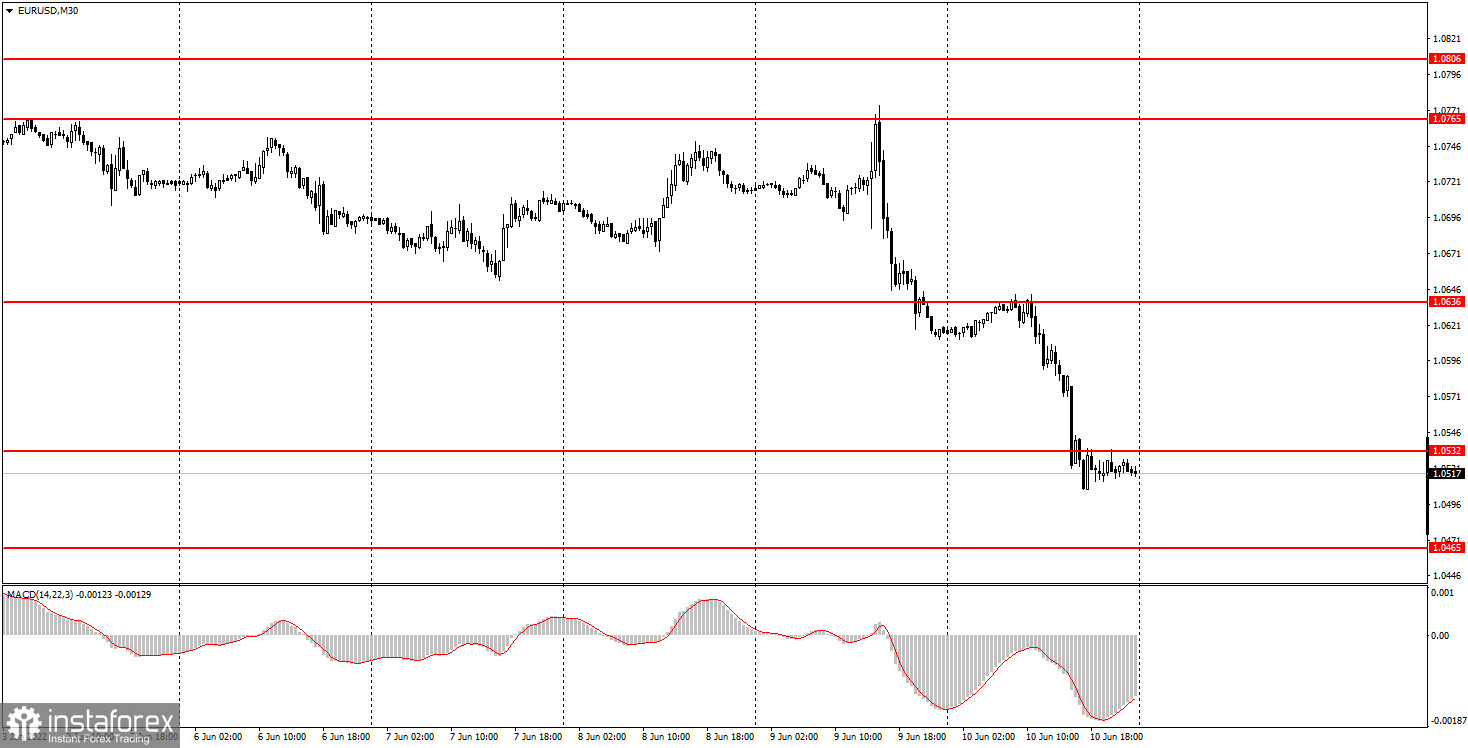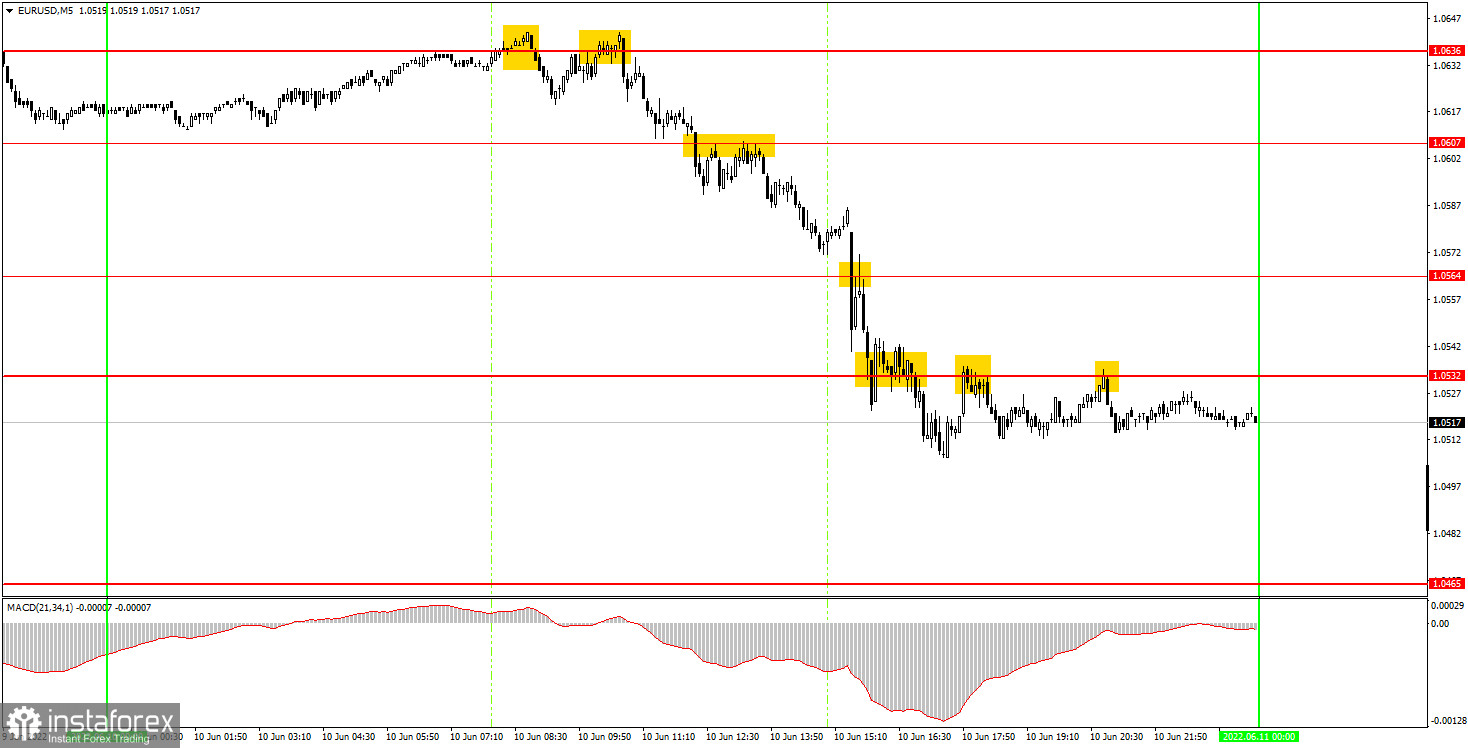Analysis of Friday's deals:
30M chart of the EUR/USD pair

The EUR/USD currency pair continued its downward movement on Friday, which began the day before, when the results of the ECB meeting were announced. Despite the fact that these same results can hardly be called dovish, the European currency collapsed. And it continued to fall amid the dollar's growth on Friday, which received support due to another crazy report on US inflation. The consumer price index in America has already risen to 8.6% y/y, as if showing that the Federal Reserve's rate hike does not bother it at all. Thus, the US central bank has not achieved any result by tightening monetary policy twice, so it is reasonable to expect that the tightening will continue. This conclusion supported the US dollar. Thus, in just two days the pair lost 200 points and left the horizontal channel. The level of 1.0636 was surpassed, so the global downward trend has now been restored. There is no downtrend line, as the price has been in the horizontal channel for almost two weeks. The euro is once again heading for its 20-year lows.
5M chart of the EUR/USD pair

The technical picture looks very cool on the 5-minute timeframe. Using the chance, once again we draw your attention to the fact that when there is a trend movement, trading is very easy and profitable. Seven trading signals were formed on Friday and all of them were for short positions. The first two were formed at the very beginning of the European session, when the price bounced twice from the level of 1.0636. At this point, short positions should have been opened. Then the pair broke through the levels of 1.0607, 1.0564 and 1.0532. From the latter, it also bounced twice from below. Since there was no signal for long positions, shorts had to be closed manually in the late afternoon. As a result, this single trade managed to earn 110 points. As you can see, there were seven signals, there was only one deal, and the profit on it was high. That's what a trend is! Volatility on Friday was even higher, but this is not surprising, as the macroeconomic background was strong.
How to trade on Monday:
The pair left the horizontal channel on the 30-minute timeframe and formed a new downward trend. There is no trend line or channel yet, but the euro has shown impressive declines over the past two days. Thus, we believe that this time traders will try to break 20-year lows around the 1.0360 level. On the 5-minute TF on Monday, it is recommended to trade at the levels of 1.0389, 1.0465, 1.0532, 1.0564, 1.0607, 1.0636, 1.0663. When passing 15 points in the right direction, you should set Stop Loss to breakeven. There will be nothing interesting in the European Union and America in macroeconomic or fundamental terms. The news calendar is empty. Thus, there is a good opportunity for a slight upward correction. In the coming days, you should figure out whether the downward trend will continue. If yes, then traders will try to get rid of the euro even on days when there are no reasons for this, and most macroeconomic statistics will be interpreted in favor of the US dollar.
Basic rules of the trading system:
1) The signal strength is calculated by the time it took to form the signal (bounce or overcome the level). The less time it took, the stronger the signal.
2) If two or more deals were opened near a certain level based on false signals (which did not trigger Take Profit or the nearest target level), then all subsequent signals from this level should be ignored.
3) In a flat, any pair can form a lot of false signals or not form them at all. But in any case, at the first signs of a flat, it is better to stop trading.
4) Trade deals are opened in the time period between the beginning of the European session and until the middle of the American one, when all deals must be closed manually.
5) On the 30-minute TF, using signals from the MACD indicator, you can trade only if there is good volatility and a trend, which is confirmed by a trend line or a trend channel.
6) If two levels are located too close to each other (from 5 to 15 points), then they should be considered as an area of support or resistance.
On the chart:
Support and Resistance Levels are the Levels that serve as targets when buying or selling the pair. You can place Take Profit near these levels.
Red lines are the channels or trend lines that display the current trend and show in which direction it is better to trade now.
The MACD indicator (14,22,3) consists of a histogram and a signal line. When they cross, this is a signal to enter the market. It is recommended to use this indicator in combination with trend lines (channels and trend lines).
Important speeches and reports (always contained in the news calendar) can greatly influence the movement of a currency pair. Therefore, during their exit, it is recommended to trade as carefully as possible or exit the market in order to avoid a sharp price reversal against the previous movement.
Beginners on Forex should remember that not every single trade has to be profitable. The development of a clear strategy and money management are the key to success in trading over a long period of time.
 English
English 
 Русский
Русский Bahasa Indonesia
Bahasa Indonesia Bahasa Malay
Bahasa Malay ไทย
ไทย Español
Español Deutsch
Deutsch Български
Български Français
Français Tiếng Việt
Tiếng Việt 中文
中文 বাংলা
বাংলা हिन्दी
हिन्दी Čeština
Čeština Українська
Українська Română
Română

